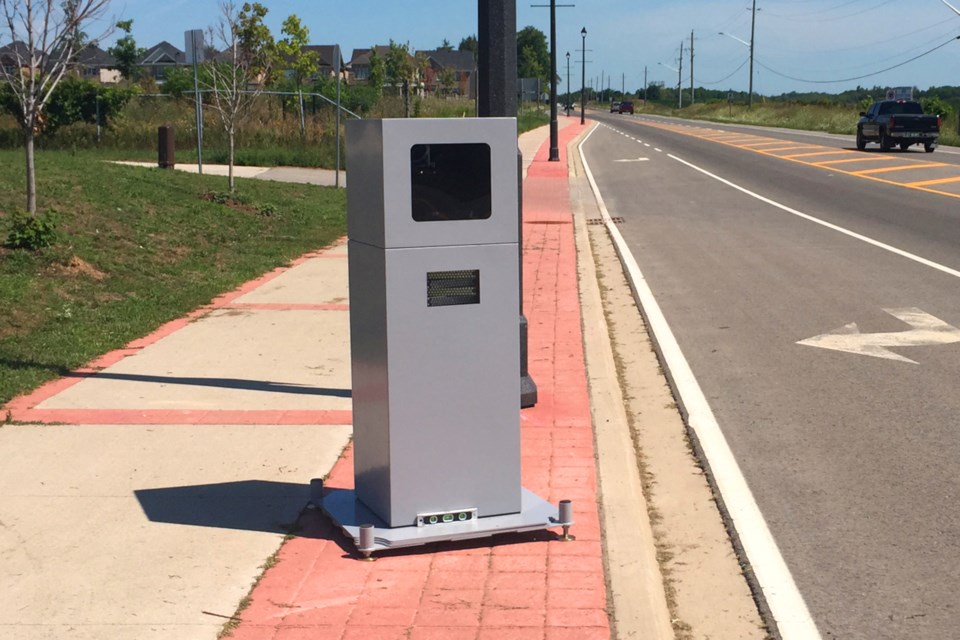Automated speed-enforcement cameras are effective at slowing down motorists and making roads safer.
At least, according to every study Sudbury.com could find.
Greater Sudbury’s six automated speed-enforcement cameras will become active on March 22, news of which sparked a flurry of public backlash claiming the program is merely a “cash grab.”
The city’s long-stated intent is for the cameras to “mitigate the safety risks associated with higher driving speeds,” as Mayor Paul Lefebvre put it in a recent media release.
“We hope to significantly reduce the number of traffic incidents and improve pedestrian, cyclist and motorist safety in our community."
Various studies show the cameras will accomplish these goals.
There are wider-reaching studies, but the closest one to Greater Sudbury we found was a 2021 report commissioned by the City of Ottawa.
This report studied the first year of an automated speed-enforcement pilot program which included seven cameras, and found a 200 per cent increase in compliance with the speed limit and a 72 per cent decrease in the percent of high-end speeders.
Once cameras were installed and enforcement began on July 13, 2020, speeds started to decrease immediately and continued to do so for several months before stabilizing by March 2021, according to the report.
Only 16 per cent of drivers obeyed the speed limit before the cameras were installed, compared to 48 per cent by the end of the one-year pilot.
Approximately 14 per cent of drivers were travelling 15 km/h or more over the speed limit before the pilot, and only four per cent were travelling at this rate by the pilot’s end.
The study included control sites, where a “fairly consistent average compliance” was noted before and during the pilot program’s timeframe, which indicates the speed cameras were likely to have had an impact.
The Ottawa study did not survey collision trends, noting industry best practice is to compare the three- or five-year collision history prior to cameras against post-camera data.
A similar study in Toronto evaluated the effectiveness of 50 mobile automated speed cameras installed near schools, from January 2020 to December 2022.
They found an overall 45-per-cent reduction in the proportion of motorists speeding near schools once cameras were operational. The percentage of drivers exceeding the speed limit dropped at nearly all sites, with 36 exceptions out of 204 locations.
Vehicle speeds were also measured 28 and 45 days after cameras were removed from 39 sites, and found that vehicles sped up but did not hit pre-camera speeds.
In 30 km/h zones, the percentage of vehicles exceeding the speed limit was:
- Pre-camera: 64.2
- With camera: 42.6
- Post-camera: 52.5
In 40 km/h zones, the percentage of vehicles exceeding the speed limit was:
- Pre-camera: 48.1
- With camera: 29.2
- Post-camera: 42.6
In 50 km/h zones, the percentage of vehicles exceeding the speed limit was:
- Pre-camera: 52.2
- With camera: 27.6
- Post-camera: 47.9
“The risk of fatal collisions rises by four to five per cent for every one km/h increase in the mean speed of vehicles,” according to the Toronto study. It also cites a less-than 50-per-cent survival rate among pedestrians involved in an impact with a vehicle at speeds greater than 45 km/h, and a 90-per-cent chance of survival at speeds below 30 km/h.
The study also found that automated speed-enforcement cameras reduced the number of collisions by from five per cent to 69 per cent. Injuries reduced by 12-65 per cent, Fatalities reduced by 17-71 per cent in the areas immediately surrounding camera sites.
A much broader study published in The Cochrane Library journal in 2010 compiled the results of 35 speed camera studies from around the world.
It found the reduction in the proportion of vehicles speeding ranged from 14-65 per cent as a result of speed enforcement cameras. They also found an eight to 49-per-cent reduction in crashes and 11 to 44-per-cent reduction in fatal and serious injuries in the vicinity of cameras.
The Ottawa report also summarizes an assessment of similar programs in Calgary, Edmonton, Winnipeg and Gatineau, which they note all reported “significant improvements” after speed-trap cameras were installed, “in reductions in total collisions; reductions in fatal collisions; reductions in injuries related to collisions; and increased compliance to posted speed limits.”
Greater Sudbury’s six automated speed-traps will become operational on March 22 from the following locations:
- Bellevue Avenue (between Picard Street and Ralph Street)
- Algonquin Road (between Maurice Street and Field Street)
- Falconbridge Road (between Donnelly Drive and Church Street)
- Main Street, Val Caron (between Justin Street and MR 80)
- Hillcrest Drive (between Brian Street and Mikkola Road)
- Gary Avenue (between Lasalle Boulevard and Madison Avenue)
The automated speed enforcement cameras are portable, and will be relocated every four months, with the new locations updated on the city’s website and shared via social media.
The city has declined to share what the speed threshold for tickets will be, but offered three fine examples on their website:
- 5 km/h over posted limit = $40
- 15 km/h over posted limit = $95
- 25 km/h over posted limit = $170
“As speed limits are not guidelines — they are the law — there is no need to disclose threshold speeds,” according to the city’s website. “Driving at, or below, the posted limit will ensure a ticket is not issued.”
For more on the city’s automated speed-enforcement program, including frequently asked questions, visit the city’s website by clicking here.
The City of Greater Sudbury conducted speed studies at the inaugural six locations prior to the installation of cameras, and will continue to do so as they shift to new locations, a city spokesperson told Sudbury.com.
An update report will be presented to city council, which will highlight the effects cameras have at each location.
Tyler Clarke covers city hall and political affairs for Sudbury.com.
